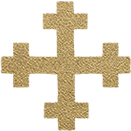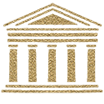Eternal Christendom’s logo captures the essence of Christendom as the civilization born from the heart of the Catholic Church by the uniting and fulfillment of revealed religion from Israel, philosophy from the Greeks, and laws and institutions from Rome by the Incarnation of Jesus Christ, who purchased this kingdom with His own blood.

The providential intersection of these three civilizations in “the fullness of time” (Gal. 4:4) was not lost on many Church Fathers, many of whom considered it a preparation for the coming of Christ.
They particularly noted the presence of three languages above Our Lord’s head when He died on the cross—Hebrew, Greek, and Latin—all translating: “Jesus King of the Jews.”
Symbolism in Our Logo

The Jerusalem Cross
The cross is appropriately at the center of the logo, as it is the source and center of Christendom. Our cross is based on the Jerusalem Cross, as the Gospel was announced to the nations beginning at Jerusalem.
“We preach Christ crucified, a stumbling block to Jews and folly to Gentiles, but to those who are called, both Jews and Greeks, Christ the power of God and the wisdom of God. For the foolishness of God is wiser than men, and the weakness of God is stronger than men.”
— St. Paul (1 Cor. 1:23-25)
“Every deed of Christ is a cause of glorying to the Catholic Church, but her greatest of all glorying is in the Cross.”
— St. Cyril of Jerusalem, Catechetical Lecture 13 (§1) (c. AD 350)
The Ten Commandments
The two tablets of the Ten Commandments represent Israel, and the divine religion which was completed and fulfilled by the coming of Jesus Christ. The tablet on the right has the first letter of the Hebrew alphabet on it, “Aleph,” referring to the first tablet of the Ten Commandments. The tablet on the left has the second letter of the Hebrew alphabet on it, “Bet,” referring to the second tablet of the Ten Commandments. They are ordered from right to left as this is the direction in which Hebrew is written. Christ summarized these two tablets as love of God and neighbor.
“Think not that I have come to abolish the law and the prophets; I have come not to abolish them but to fulfill them. For truly, I say to you, till heaven and earth pass away, not an iota, not a dot, will pass from the law until all is accomplished. Whoever then relaxes one of the least of these commandments and teaches men so, shall be called least in the kingdom of heaven; but he who does them and teaches them shall be called great in the kingdom of heaven.”
— Our Lord (Matt. 5:17-19)
“You shall love the Lord your God with all your heart, and with all your soul, and with all your mind. This is the great and first commandment. And a second is like it, you shall love your neighbor as yourself. On these two commandments depend all the law and the prophets.”
— Our Lord (Matt. 22:37-40)


The Parthenon
The Parthenon in Athens represents Greece, and the heights of truth it was able to attain through philosophy and the power of human reason unaided by divine revelation. While reason and philosophy are signified by Greece, it nonetheless includes all those peoples and nations that witness to the existence of one God, the unchanging natural law, and the immutable moral law, all without the assistance of divine revelation.
“For what can be known about God is plain to them, because God has shown it to them. Ever since the creation of the world his invisible nature, namely, his eternal power and deity, has been clearly perceived in the things that have been made. So they are without excuse…When Gentiles who have not the law do by nature what the law requires, they are a law to themselves, even though they do not have the law. They show that what the law requires is written on their hearts…”
— St. Paul (Rom. 1:19; 2:14-15)
“But if the Hellenic (Greek) philosophy comprehends not the whole extent of the truth, and besides is destitute of strength to perform the commandments of the Lord, yet it prepares the way for the truly royal teaching; training in some way or other, and molding the character, and fitting him who believes in Providence for the reception of the truth.”
— St. Clement of Alexandria, The Stromata (Book 1, Ch. 16) (c. 198-203)
The Colosseum
The Coliseum represents Rome, and the arts of civilization the Romans implemented to govern an Empire spanning three continents. The most important of these were Rome’s laws and political institutions.
“And there shall be a fourth kingdom, strong as iron, because iron breaks to pieces and shatters all things; and like iron which crushes, it shall break and crush all these [kingdoms]…There shall be a fourth kingdom on earth, which shall be different from all the kingdoms, and it shall devour the whole earth, and trample it down, and break it to pieces.”
— The Prophet Daniel (Dan. 2:40, 7:23)
“Your task, Roman, and do not forget it,
will be to govern the peoples of the world in your empire.
These will be your arts—and to impose a settled pattern upon peace,
to pardon the defeated and war down the proud.”
— Virgil, Aeneid (Book 6)
“The grace stored in Jerusalem, and the gifts which radiate from Athens, are made over and concentrated in Rome. This is true as a matter of history. Rome has inherited both sacred and profane learning; she has perpetuated and dispensed the traditions of Moses and David in the supernatural order, and of Homer and Aristotle in the natural. To separate those distinct teachings, human and divine, which meet in Rome, is to retrograde; it is to rebuild the Jewish Temple and to plant anew the groves of Academus.”
— St. John Henry Newman, The Idea of a University: Christianity and Letters (1854)


Truth, Goodness, Beauty
Crown of Victory
The “Truth, Goodness, Beauty” on the top outer ring signifies the three traditional “transcendentals,” or properties of Being itself. Their source is God, and they are the highest aspirations of the human soul. Each on their own is alluring. But the unity of all three represents the highest happiness.
The crown of victory on the bottom of the outer ring signifies the prize—the crown—that every Christian strives to attain from Christ in eternity.
“Do you not know that in a race all the runners compete, but only one receives the prize? So run that you may obtain it.”
— St. Paul (1 Cor. 9:25)
“Blessed is the man who endures trial, for when he has stood the test he will receive the crown of life which God has promised to those who love him.”
— St. James (Jas. 1:12)
“And when the chief Shepherd is manifested you will obtain the unfading crown of glory.”
— St. Peter (1 Pet. 5:4)
“Be faithful unto death, and I will give you the crown of life.”
— Our Lord (Apoc. 2:10)
The Holy Trinity
The triple clover leaf pattern, and the rays which emanate from it in the inner part of the logo, represent the Holy Trinity, its glory, and the glory it imparts to man by inhabiting his soul, not because of our own works, but by His merciful gift through the grace of the sacraments. By making His dwelling in the human soul, the Trinity has made man a temple, and fitted him into the Temple of the Church, rendering him capable of offering right worship to God through Jesus Christ.
“All authority in heaven and on earth has been given to me. Go therefore and make disciples of all nations, baptizing them in the name of the Father and of the Son and of the Holy Spirit, teaching them to observe all that I have commanded you; and lo, I am with you always, to the close of the age.”
— Our Lord (Matt. 28:18-20)
“Do you not know that you are God’s temple, and that God’s Spirit dwells in you? If anyone destroys God’s temple, God will destroy Him. For God’s temple is holy, and that temple you are.”
— St. Paul (1 Cor. 3:16-17)
“So then you are no longer strangers and sojourners, but you are fellow citizens with the saints and members of the household of God, built upon the foundation of the apostles and prophets, Christ Jesus himself being the cornerstone, in whom the whole structure is joined together and grows into a holy temple in the Lord; in whom you also are built into it for a dwelling place of God in the Spirit.”
— St. Paul (Eph. 2:19-22)
“His divine power has granted to us all things that pertain to life and godliness, through the knowledge of him who called us to his own glory and excellence, by which he has granted to us his precious and very great promises, that through these you may escape from the corruption that is in the world because of passion, and become partakers of the divine nature.”
— St. Peter (2 Pet. 1:3-4)

